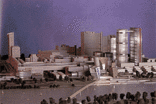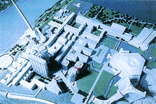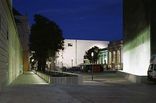Bauwerk
Donau-City
Margarethe Cufer, Hans Hollein, Adolf Krischanitz, Hermann Czech, Arata Isozaki, Roman Delugan, Gustav Peichl, Heinz Neumann, Michael Loudon, Wilhelm Holzbauer - Wien (A) - 1999
25. April 1999 - Az W
Since 1990, the creation of a mixed-use area has been envisioned in the space between the Uno-City and the Hubertus dam. When the area was considered for the 1995 World’s Fair, co-planned between Vienna and Budapest, the judging of the architectural competition focused especially on the future usability of the expo area.
The design of the winners, Hans Hollein and Coop Himmelb(l)au, was then used as the basis for the zoning proposal and the development plan. The expo was subsequently cancelled because of a public referendum, and the designated area was converted into a waste disposal site. Later, the building company WED covered the highway that runs parallel to the Danube and through the area, and commissioned architects Krischanitz and Heinz Neumann to create a master plan.
Maintaining Hollein’s and Himmelb(l)au’s idea of an urban diagonal, the new master plan divides the area into a three-dimensional grid at various levels of public space, which allows for different constellations of building within strict orthogonal principles. The main – or pedestrian – level is separated from the access and infrastructure level below, designed as an open, green space. With this master plan as a basis, two commissions of experts, consisting of 15 invited architects, met in 1993 to finalize the project.
As a result, Cufer+Partner, Hermann Czech, Delugan_Meissl and Michael Loudon devised the main conception for the „apartment park complex Donau-City.“ Hermann Czech could not comply with the construction company’s demands for cost reduction, and so Eric Steiner assumed leadership of the project.
By 2001 the Mischek-Tower (an apartment building) and the office buildings Andromeda-Tower and Ares-Tower were completed, in addition to other apartment buildings completed in 1998/99. The Tech-Gate contains offices as well as a center for technology.
West of the area are Hans Hollein’s grammar school and Krischanitz’s fire station; Heinz Tesar’s church welcomes visitors at the east entrance of the Donau-City.
Unfortunately two designs featured in the original development plan, Hans Hollein’s Guggenheim museum and the Twin-Towers, a combined effort of Arata Isozaki and Gustav Peichl, will remain projects on paper.
The design of the winners, Hans Hollein and Coop Himmelb(l)au, was then used as the basis for the zoning proposal and the development plan. The expo was subsequently cancelled because of a public referendum, and the designated area was converted into a waste disposal site. Later, the building company WED covered the highway that runs parallel to the Danube and through the area, and commissioned architects Krischanitz and Heinz Neumann to create a master plan.
Maintaining Hollein’s and Himmelb(l)au’s idea of an urban diagonal, the new master plan divides the area into a three-dimensional grid at various levels of public space, which allows for different constellations of building within strict orthogonal principles. The main – or pedestrian – level is separated from the access and infrastructure level below, designed as an open, green space. With this master plan as a basis, two commissions of experts, consisting of 15 invited architects, met in 1993 to finalize the project.
As a result, Cufer+Partner, Hermann Czech, Delugan_Meissl and Michael Loudon devised the main conception for the „apartment park complex Donau-City.“ Hermann Czech could not comply with the construction company’s demands for cost reduction, and so Eric Steiner assumed leadership of the project.
By 2001 the Mischek-Tower (an apartment building) and the office buildings Andromeda-Tower and Ares-Tower were completed, in addition to other apartment buildings completed in 1998/99. The Tech-Gate contains offices as well as a center for technology.
West of the area are Hans Hollein’s grammar school and Krischanitz’s fire station; Heinz Tesar’s church welcomes visitors at the east entrance of the Donau-City.
Unfortunately two designs featured in the original development plan, Hans Hollein’s Guggenheim museum and the Twin-Towers, a combined effort of Arata Isozaki and Gustav Peichl, will remain projects on paper.
Für den Beitrag verantwortlich: Architekturzentrum Wien
Ansprechpartner:in für diese Seite: Maria Welzig
Presseschau









